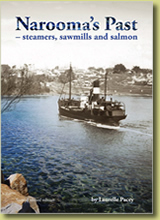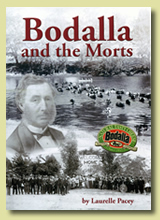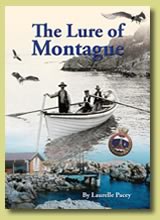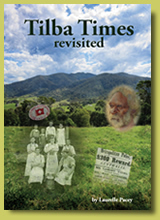Narooma's Past

140 pages, 189 images with maps and table of ships that called at Narooma.
Cost $38, plus $10 p&p.

Bodalla and the Morts explains why the small village of Bodalla has two
beautiful churches designed by celebrated nineteenth century architects,
and a hotel once considered by the well-to-do the only place worth staying
south of Kiama.
It details Bodalla’s pioneering role in the Australian cheese industry, initially
due to the determination of Thomas Sutcliffe Mort.
Mort was a leading figure in trade and commerce in mid nineteenth century
NSW. He believed passionately the growing Colony should develop its own agriculture
and manufacturing industries. His enterprises included the auction of wool
and pastoral properties, building ships and locomotives, gold mining and
shipping, and a pioneering role in the frozen meat export trade.
Mort established the Bodalla Estate in 1860 as his country residence, but
went on to show how cheesemaking in Australia could move from being a cottage
to a factory industry.
The book’s main focus is on the Mort family’s long association with Bodalla,
the Estate’s various stages under different managers, through to the sale
of the Bodalla Company and the Estate to Panfida in its bid to control the
Sydney milk market, and the subsequent break-up of the Estate.
Bodalla and the Morts draws extensively on primary sources – Bodalla Company
records, contemporary newspaper articles, and Mort family letters and journals
– and is enriched with many early photographs from the Mort family archives.
144 pages, over 160 images. Cost $40, plus $9 p&p.

Narooma was once quite a busy port with up to three ships in port at the
one time. Ships took timber from its sawmills to Sydney and returned with
supplies for the town.
Yet little remains today to remind us of the many ships and seamen who braved
the bar at the Inlet’s entrance, of the ships built in the Inlet, or of the
frustrations when ships were bar-bound, and attempts to improve Narooma as
a port.
Many goldminers passed through the area, some staying a short while, while
bullockies, millhands and sawmillers worked the forests around Wagonga Inlet
for almost 100 years.
Narooma had Australia’s first fish cannery, following the visit of American
author and game fisherman Zane Grey, where salmon and tuna were canned for
many years. It also had private hotels and guesthouses with a style and glamour
most other south coast towns lacked.
Narooma has been a tourist destination for almost 100 years, but in the 1920s
and 30s it was the holiday destination for the adventurous or well-to-do
people from grazing properties out west and professional people from Sydney.
They enjoyed regattas at Ringlands Point, picnics up the river or out to
Montague Island, and big game fishing off the coast.
88 pages, 102 images including maps. Cost $30, plus $3

The Lure of Montague includes stories about the construction of the lighthouse
and the keepers’ residences, about living on Montague and the difficulties
families had in receiving supplies, the secret Navy station, and the impact
of a remarkable woman Judith Cassell in her determination to conserve the
island’s seabirds, Little Penguins and seals.
It also tells of many characters associated with Montague over the years,
including Ian Cameron whose association with Montague went back over 80 years
to when his father was a lightkeeper culminating in Ian being in charge of
lighthouse maintenance in NSW.
There are also stories about the island’s cunning horse that preferred swimming
to the mainland to working, and the formation of the first gamefishing club
in Australia at a camp on Montague.
More recent history includes the community’s fight in the 1980s to keep lightkeepers
on Montague, to keep the Light mechanism in Narooma, and the Commonwealth
handing the island’s management over to the National Parks and Wildlife Service
of NSW, and its subsequent challenges.
72 pages, 64 images (including maps). Cost $25, plus $3 p&p.


Tilba Times tells of the local Aboriginal people and their close ties with
the Bate family, the development of cheese factories in the district, and
of mining on the mountain when Gulaga was once home to about 300 people.
Tilba Tilba was once the major village in the district, predating Narooma
and Central Tilba. It had a reticulated water supply and generated its own
electricity long before other places on the south coast.
Central Tilba grew up around the ABC Cheese factory, the first cheese co-operative
in NSW.
When the Co-op merged with the Bega Co-op in 1972, Central Tilba had to reinvent
itself to survive. This led to its National Trust heritage listing and a
new phase for the area led by a pride in its past.
It includes a small history of each of the main properties in the area.
64 pages, 63 images (including maps). Cost $22, plus $3 p&p.



140 pages, 189 images with maps and table of ships that called at Narooma.
Cost $38, plus $10 p&p.